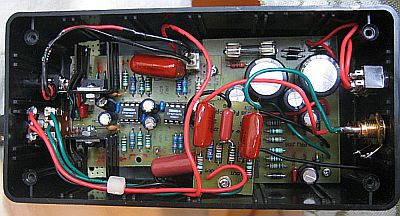| |
 |
| | | |
| |
Introduction |
|
| | | |
| |
The portable headphone amplifier is a solid state device that was used originally in my home hifi headphone amplifier as described here. I had already built a CMoy-based portable headphone amplifier described here, but I wanted to use the OPA/BUF circuit to make a better unit to use with my office computer and my Sennheiser HD497 headphones, and improve the sound quality of the MP3's I listen to at work. |
|
| | | |
| |
 |
| | | |
| |
This amplifier is not really "portable" because it requires an AC power pack and cannot be run on batteries like the CMoy-style amplifier. But, I still wanted it relatively small, so I put the amplifier in a 6" x 3" x 2" Radio Shack project box. The front of the amplifier (left side of the above photo) has a 1/8" headphone jack, a small green LED indicator light, and a volume control. |
|
| | | |
| |
On the back (right side of the above photo) are two gold-plated RCA input jacks, an on/off switch, and the external AC power pack connector. I took a standard, shielded patch cable with RCA plugs at one end, and attached a 1/8" miniplug at the other end to connect the amplifier to a sound card or portable CD player. |
|
| | | |
| |
 |
| | | |
| |
Inside the case, the photo above shows the amplifier and power supply on two separate circuit boards, the crossfeed board mounted above the power supply board, and the internal wiring for all of the switches, LED, volume control, crossfeed board, input and output jacks. |
|
| | | |
| |
Power Supply |
|
| | | |
| |
The power supply is a modified version of the ESP Project 5A as described here. I used parts I had on hand, so the smoothing caps consist of one 2,200 uF and one 1,000 uF cap per rail. I also used 100 uF caps downstream from the regulators instead of the 10 uF recommened by ESP. The schematic for the power supply is shown below. |
|
| | | |
| |
 |
| | | |
| |
The power supply is fed with a 12 VAC, 1 A external power pack, and it produces a clean, steady +/- 12.2 VDC. The incoming AC current is run first through a 3/4 A fast-blow fuse before feeding the rectifier diodes. |
|
| | | |
| |
The power supply was built on a separate PCB, then bolted, Frankenstein-like, to the sawed-off amplifier board. |
|
| | | |
| |
Crossfeed Circuit |
|
| | | |
| |
The signal from the RCA input input jacks is routed to a bass-enhanced, natural crossfeed circuit, as described on the hifi headphone amplifier page. Here there is only one setting (approximately equivalent to the High setting on the other amplifier). The small, separate crossfeed circuit board is suspended above the upper left quarter of the power supply PCB on a 1" high standoff. The circuit is shown on the amplifier schematic in the following section. |
|
| | | |
| |
The output from the crossfeed circuit then goes through the super el-cheapo Radio Shack 50 Kohm, dual-gange audio volume potentiometer, then into the amplifier circuit. |
|
| | | |
| |
Headphone Amplifier Circuit |
|
| | | |
| |
The amplifier circuit is the same one used in the original home hifi headphone amplifier as described here. I removed the input stage so only two stages remain, the OPA2134 gain stage and the OPA2134/BUF634 output stage. The shematic for one channel is shown below. |
|
| | | |
| |
 |
| | | |
| |
The signal input from the volume control enters the amplifier circuit through a 1 uF polypropylene capacitor, a 100 Kohm resistor to ground to set the input impedance, and a 1 Kohm serial resistor to dampen oscillation. The OPA2134 amplifier is set to a gain of 4.7X. |
|
| | | |
| |
The buffered output stage uses an OPA2134 opamp and BUF634 buffers, and has a gain of about 1.03X, giving the whole system a gain of about 4X. Actually, this output stage was originally bought for the DAC, and is based on a design by Pavel Macura. |
|
| | | |
| |
The buffers lower the output impedence so that headphones (30 to 300 ohms) can be driven, and the buffers are capable of providing considerably more current then the opamps alone. These features greatly improve the sound. A jumper on the output allows you to set the output impedance at either 120 or 50 ohms. |
|
| | | |
| |
The resistor and transistor networks used originally to "force" the opamps into class-A using a single 2N5457 JFET transistor and an 847 ohm source resistor between the (-) rail and the output were removed. TheBUF634 buffers are still run in class-A by connecting the BW pin to the (-) rail without a resistor. |
|
| | | |
| |
Conclusion |
|
| | | |
| |
How does it sound? Excellent; noticably better than the first Cmoy-style portable headphone I made. The BUF634 output stage really adds a lot of "bass slam", as they say. |
|
| | | |
| |
Note:After months of messing-around with this amplifier, I accidentally broke off a leg on one of the BUF634s. As a result, I rebuilt the whole thing, new circuit board, parts, etc., as described here. |
|
| | | |
| |
Back |
|




